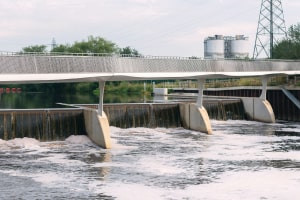How do you control the water of a river? Why do you need to do so? Rivers and dams supply water for drinking, growing crops, manufacturing, energy and transport. They have allowed the progress of civilisations along their banks, however they can also cause devastation through floods and drought if not properly managed. River engineering is a branch of civil engineering that involves the design and construction of structures to manage and improve rivers. It helps society by enhancing the numerous benefits of their systems while mitigating their adverse effects on the environment. This course aims to explain the principles of river dynamics, introducing engineering concepts and exploring design practice as used in riverbank protection and flood planning.
Beginning with an overview of the field, you will be taught the properties of sediment covering shape, size distributions, terminal fall velocity and suspended sediment mixtures. You will go on to discuss hydrodynamics, including mass conservation equations, momentums and energy equations. The river flood waves will be presented, covering celerity, diffusive waves and loop rating curves. Next, the course will explain sediment transport in the rivers, covering the basics on near-bed hydraulics, bedload, suspended sediment concentrations, turbulence bursting, turbulent characteristics, morphology process, advanced sediment transport and the interventions of society, all in an integrated way. Following from this, discover dynamic river cycles, how rivers change due to hydrology, fluvial processes, the long-term morphology change and the driving factors like society’s influence on the environment.
There are many mathematical modelling concepts and tools available to model natural river behaviour. The course will discuss specific energy, specific force and critical flow in a river flow system and how this energy dissipates. It explains the mass conservation equation and the linear momentum equation and their application in solving the ongoing river flow problems. Next, the flood wave celerity loop rating curve will be discussed and case studies will be presented on existing river systems and how to apply learned knowledge. Different types of representations will be uncovered and the formation of scour holes and vortex formations will also be explained. Would you like to know how to maintain the ecological health of rivers? By understanding the fundamentals of river engineering, you will begin to know how you can make a difference. Do you want to be part of the solution to saving our natural world? Start this course today and help keep our natural resources viable!
What You Will Learn In This Free Course
View All Learning Outcomes View Less All Alison courses are free to enrol, study, and complete. To successfully complete this Diploma course and become an Alison Graduate, you need to achieve 80% or higher in each course assessment.
Once you have completed this Diploma course, you have the option to acquire an official Diploma, which is a great way to share your achievement with the world.
Your Alison certificate is:
- Ideal for sharing with potential employers.
- Great for your CV, professional social media profiles, and job applications.
- An indication of your commitment to continuously learn, upskill, and achieve high results.
- An incentive for you to continue empowering yourself through lifelong learning.
Alison offers 2 types of Diploma for completed Diploma courses:
- Digital Diploma: a downloadable Diploma in PDF format immediately available to you when you complete your purchase.
- Physical Diploma: a physical version of your officially branded and security-marked Diploma
All Diplomas are available to purchase through the Alison Shop. For more information on purchasing Alison Diploma, please visit our FAQs. If you decide not to purchase your Alison Diploma, you can still demonstrate your achievement by sharing your Learner Record or Learner Achievement Verification, both of which are accessible from your Account Settings.











 Avg. Hours
Avg. Hours  CPD Accredited
CPD Accredited 
 Total XP:
Total XP: 
 Knowledge & Skills You Will Learn
Knowledge & Skills You Will Learn 






